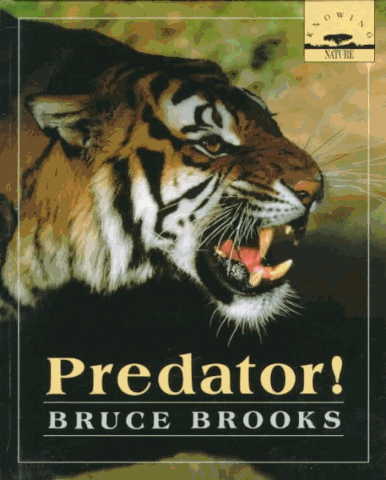Bears
An introduction to the physical characteristics, habits, natural environment, and future prospects of the three species of bears that live in North America.
599.74
year: 1993
copies: 16
call number/section: 599.74
lexile: 900
Predators
Describes briefly the characteristics and natural environment of various predatory animals and discusses some of their problems in finding food.
596
year: 1983
copies: 2
call number/section: 596
lexile:
Reptiles
Describes how various reptiles use ways to disguise themselves and fool other animals, including camouflage, lures, and other tricks with color and shape.
597.9
year: 1998
copies: 31
call number/section: 597.9
lexile: 830
Meat-eating Dinosaurs
Full-color illustrations describe a number of prehistoric meat-eating dinosaurs including the Utahraptor and the Tyrannosaurus Rex.
567.9
year: 2007
copies: 5
call number/section: 567.9
lexile: 890
Small & Deadly Dinosaurs
Text and illustrations introduce thirteen small but powerful dinosaurs, including the velociraptor, oviraptor, and herrerasaur, showing their size relative to humans and describing their bodies, where they lived, how they hunted, and how they defended themselves.
567.9
year: 2007
copies: 3
call number/section: 567.9
lexile: 880
Big Predators
Simple text and photographs describe large predators including tigers, eagles, tarantulas, anacondas, crocodiles, and more.
591.5
year: 2010
copies: 13
call number/section: 591.5
lexile: 460
subjects: predatory animals [X]
Saurophaganax And Other Meat-eating Dinosaurs
This is a description of how the Saurophaganax and other meat-eating dinosaurs of South America survived and what they have in common with today's animals.
567.91
year: 2009
copies: 4
call number/section: 567.91
lexile: 810
Predator!
Survival in the wild creates a hierarchy of predators and their prey; this interaction among the animals forms the basis of a complex ecological system known as the food chain.
591.53
year: 1991
copies: 6
call number/section: 591.53
lexile:
Predators
Discusses the feeding habits and hunting methods of various predatory animals, demonstrating how they maintain the food chain.
591.53
year: 1991
copies: 3
call number/section: 591.53
lexile:
Savage Safari
An illustrated discussion of how wild animals on the African safari thrive, highlighting their hunting and hiding methods and the unique skills they have developed in order to survive.
591.5
year: 2010
copies: 2
call number/section: 591.5
lexile: 1100
Birds
Describes the various ways in which some birds disguise themselves to fool other animals, including camouflage and other tricks with color and shape.
598
year: 1998
copies: 28
call number/section: 598
lexile: 830
Canines
Describes the physical characteristics, hunting habits, natural environment, and relationship to humans of various wild members of the dog family including wolves, foxes, and coyotes.
599.74
year: 1993
copies: 7
call number/section: 599.74
lexile: 870
Tyrannosaurus And Other Giant Meat-eaters
An introduction to the physical characteristics and habits of Tyrannosaurus rex and other meat-eating dinosaurs.
567.91
year: 2003
copies: 2
call number/section: 567.91
lexile:
Wild Cats
Introduces bobcats, lynxes, jaguars, and cougars, all endangered wild cats of North America.
599.75
year: 1993
copies: 5
call number/section: 599.75
lexile: 900
Deadly!
Introduces some of the most dangerous animals in the world, including cheetahs, sharks, owls, bears, and jellyfish.
591.6
year: 2015
copies: 33
call number/section: 591.6
lexile: 1230














